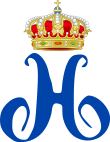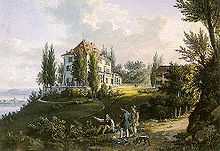- Hortense de Beauharnais
-
Hortense de Beauharnais Queen Consort of Holland
Comtesse de Saint-Leu
Duchesse de Saint-Leu
Hortense de Beauharnais, Queen of Holland Queen Consort of Holland Tenure 5 June 1806 – 1 July 1810 Spouse Louis Bonaparte, King of Holland Issue Napoléon Louis Charles Bonaparte
Napoleon Louis Bonaparte
Napoleon III of France
Charles Auguste Louis Joseph, duc de Morny (illegitimate)House House of Bonaparte (by marriage)
House of Beauharnais (by birth)Father Alexandre, Vicomte de Beauharnais Mother Joséphine Tascher de la Pagerie Born 10 April 1783
Paris, Kingdom of FranceDied 5 October 1837 (aged 54)
Chateau of Arenenberg, Thurgau, SwitzerlandBurial St Pierre-St Paul Church, Rueil-Malmaison, France Religion Roman Catholic Hortense Eugénie Cécile Bonaparte (French pronunciation: [ɔʁtɑ̃s øʒeni sesil bɔnapaʁt]) (née de Beauharnais, pronounced: [də boaʁnɛ]) (10 April 1783 – 5 October 1837), Queen Consort of Holland, was the stepdaughter of Emperor Napoleon I, being the daughter of his first wife, Joséphine de Beauharnais. She later became the wife of the former's brother, Louis Bonaparte, King of Holland, and the mother of Napoleon III, Emperor of the French. She had also an illegitimate son, Charles Auguste Louis Joseph, duc de Morny by her lover Charles Joseph, comte de Flahaut.
Contents
Early life
Hortense was born in Paris, France on 10 April 1783, the daughter of Alexandre, Vicomte de Beauharnais and Joséphine Tascher de la Pagerie. Her parents separated shortly after her birth. Her father was executed on 23 July 1794, at the time of the French Revolution, a few days before the end of the Reign of Terror. Her mother was imprisoned in the Carmes prison, from which she was released on 6 August 1794, thanks to the intervention of her best friend Thérèse Tallien. Two years later, her mother married Napoleon Bonaparte.
Hortense was described as having been an amusing and pretty child with long, pale golden-blonde hair and blue eyes.[1] She received her education at the school of Madame Jeanne Campan in St-Germain-en-Laye together with Napoleon's youngest sister Caroline Bonaparte, who later married Joachim Murat.[1] She had an elder brother, Eugène de Beauharnais. Hortense was an accomplished amateur musical composer and supplied the army of her stepfather with rousing marches.[2] She also enjoyed playing games and particularly excelled at billiards.[3]
Marriage
In 1802, at Napoleon's request, Hortense married his brother Louis Bonaparte. The couple had three sons:
- Napoléon Louis Charles Bonaparte (10 October 1802 - 5 May 1807)
- Napoleon Louis Bonaparte (11 October 1804 - 17 March 1831)
- Charles Louis Napoléon Bonaparte, later Napoleon III, Emperor of the French (20 April 1808- 9 January 1873)
Queen
In 1806, Napoleon appointed his brother Louis to be the King of Holland, and Hortense accompanied her husband to The Hague. Hortense's negativity towards being appointed Queen of Holland was twofold: First, it was necessary for her to move there with Louis, with whom she did not get along, and second, she had to leave her life as a celebrated member of Parisian society. She had hoped to be "a Queen of Holland in Paris", but Napoleon did not agree. She was therefore forced to depart with Louis to the Netherlands, where she arrived on 18 June 1806.
Queen Hortense was pleasantly surprised [4] by the warm welcome from the public. She quickly became accustomed to life in the Netherlands and came to like the country. She was present at official celebrations and ceremonies, visited the market places where she made large purchases, and was much liked by the public, which annoyed her husband. She learned water colour painting and made trips around the countryside. Nevertheless, she hated her stay there because of her bad relationship with Louis: The couple lived in different parts of the palace and avoided each other at every opportunity, with Hortense describing herself as a prisoner.[4] In 1807, her son died; she was subsequently allowed to visit France as the climate there was considered better for her other son Louis-Napoléon. She remained in France, again pleased by her status as queen at the French court, until 1810, when Napoleon forced her to return to the Netherlands at his new wedding—he did not consider it suitable to have the daughter of his former spouse at court. Hortense returned temporarily to the Netherlands, but on 1 June 1810, she was allowed to leave again on the pretext of her health.
In 1810, after his Dutch kingdom was taken away from him, Louis remained in Holland for nearly three years, turning to writing and poetry. Louis wrote to Napoleon after the latter's defeat in Russia to request that the Dutch throne be restored to him. However, Napoleon refused. Louis finally returned to France in 1813, where he remained for the rest of his life.
Illegitimate son
Hortense was now free to respond to the romantic overtures of the man whom she had long admired, Colonel Charles Joseph, Comte de Flahaut, a sophisticated, handsome man rumoured to be the illegitimate son of Talleyrand.[5] They soon became lovers. In 1811, at an unspecified inn in Switzerland, close to Lake Geneva, Hortense secretly gave birth to a son by de Flahaut,
- Charles Auguste Louis Joseph ( 21 October 1811 - 10 March 1865), created Duc de Morny by his half-brother, Napoleon III, in 1862.
Only her brother Eugène, Adélaïde Filleul de Souza, de Flahaut's mother, and her closest companions were aware of her pregnancy and the subsequent birth. She had used poor health to explain her prolonged visit to Switzerland, the journey having been arranged by Adélaïde. Hortense cleverly disguised her pregnancy (she was by then, in her sixth month), during the baptism of Napoleon's son, Napoleon II when she was chosen to be one of the child's godmothers, an honour she shared with Madame Mère, mother of the Emperor.
Later years
At the Bourbon Restoration in 1814, Hortense received the protection of Alexander I, Tsar of Russia; at his instigation she was created duchess of Saint-Leu by King Louis XVIII. During the Hundred Days, however, Hortense supported her stepfather and brother-in-law Napoleon. This led to her banishment from France after his final defeat. She traveled in Germany and Italy before purchasing the Château of Arenenberg in the Swiss canton of Thurgau in 1817. She lived there until her death on 5 October 1837, at the age of fifty-four. She is buried next to her mother Joséphine in the Saint-Pierre-Saint-Paul church in Rueil-Malmaison.
A portrait of Hortense hangs at Ash Lawn-Highland, the Virginia plantation home of James Monroe, 5th President of the United States. It was one of three portraits given by Hortense to Monroe's daughter Eliza, who went to school with Hortense in France. (The other two portraits are of Hortense's brother Eugène de Beauharnais and of Madame Campan, the headmistress of the school attended by Hortense and Eliza). Eliza's daughter, Hortensia Monroe Hay was named in honour of Hortense.
Ancestry
Ancestors of Hortense de Beauharnais 16. François de Beauharnais, seigneur de La Boische 8. Claude de Beauharnais, comte des Roches-Baritaud 17. Marguerite Françoise de Pyvart de Chastillé 4. François de Beauharnais, marquis de la Ferté-Beauharnais 18. Pierre Hardouineau, seigneur de La Laudanière 9. Renée Hardouineau de Laudanière 19. Renée Le Pays de Beauville 2. Alexandre, vicomte de Beauharnais 20. Jacques Pyvart de Chastullé 10. François-Louis de Pyvart de Chastullé 21. Madeleine de Beauchesne 5. Marie Anne Henriette Françoise de Pyvart de Chastullé 22. Pierre Hardouineau, seigneur de La Laudanière 11. Jeanne Hardouineau de Laudanière 23. Renée Le Pays de Beauville 1. Hortense de Beauharnais 24. Gaspard de Tascher, seigneur de la Pagerie 12. Gaspard Joseph Tascher de la Pagerie 25. Edmée Henriette Madeleine du Plessis de Savonnières 6. Joseph-Gaspard Tascher de la Pagerie 26. François Bourreau, seigneur de la Chevalerie 13. Françoise Bourreau de la Chevalerie 27. Marie Thérèse Jaham des Prés 3. Joséphine Tascher de La Pagerie 28. Joseph des Vergers de Sablons 14. Joseph François des Vergers de Sannois 29. Élisabeth de Maigne du Plat 7. Rose-Claire des Vergers de Sannois 30. Anthony Brown 15. Catherine Marie Brown 31. Catherine des Vergers de Sannois References
- ^ a b >Epton, Nina (1975). Josephine: The Empress and Her Children. New York: W. W. Norton & Company, Inc. p.51
- ^ Partant pour la Syrie
- ^ Epton, pp.99-100
- ^ a b http://www.inghist.nl/Onderzoek/Projecten/DVN/lemmata/data/Hortense%20de%20Beauharnais
- ^ Mossiker, Frances, Napoleon and Josephine: The Biography of a Marriage, Simon & Schuster, New York, 1964, p. 347, ISBN 1199380784 ISBN 978-1199380784
Further reading
- Epton, Nina (1976). Josephine: The Empress and her Children. London: Norton. ISBN 0393075001.
External links
- Partant pour la Syrie - composed by Hortense de Beauharnais
- Hortense de Beauharnais, Queen of Holland
- Hortense - La Reine d'Hollande
- Queen Hortense - A Life Picture of the Napoleonic Era - 1910 book by L. Mühlbach, as an eText from Project Gutenberg
- Spencer Napoleonica Collection at Newberry Library
Hortense de BeauharnaisBorn: 10 April 1783 Died: 5 October 1837Dutch royalty Vacant Title last held byMaria Theresa of Naples and Sicily
as Consort of the Austrian NetherlandsQueen consort of Holland
5 June 1806 – 1 July 1810Vacant Title next held byWilhelmine of Prussia
as Queen of the NetherlandsDutch Royal Consorts Vacant
Prince Claus van Amsberg (1980–2002) · Prince Bernhard of Lippe-Biesterfeld (1948–1980) · Duke Henry of Mecklenburg-Schwerin (1901–1934) · Princess Emma of Waldeck and Pyrmont (1879–1890) · Princess Sophie of Württemberg (1849–1877) · Grand Duchess Anna Pavlovna of Russia (1840–1849) · Princess Wilhelmine of Prussia (1813–1837)· Hortense de Beauharnais (1806–1810)·1st generation 2nd generation François • François VI, Marquis de La Ferté-Beauharnais m. Françoise de Beauharnais • Claude, 2nd Count of Roches-Baritaud • Anne, Countess de Barral • Alexandre, Viscount of Beauharnais m. Joséphine Tascher de La Pagerie (later Empress of the French)3rd generation Adélaïde • Françoise • Émilie, Countess of Lavalette • Eugène, Duke of Leuchtenberg* m. Princess Augusta of Bavaria • Amedee • Hortense, Queen of Holland* • Alberic • Stéphanie, Grand Duchess of Baden* • Josephine, Marquise de Quiqueran-Beaujeu • Eugénie • Hortense, Countess de Querelles • Auguste4th generation Joséphine, Queen of Sweden and Norway** • Eugénie, Princess of Hohenzollern-Hechingen** • Auguste, Duke of Leuchtenberg** m. Queen Maria II of Portugal • Amélie, Empress of Brazil** • Théodolinde, Countess of Württemberg** • Carolina** • Maximilian, Duke of Leuchtenberg**^ m. Grand Duchess Maria Nikolaevna of Russia5th generation Alexandra**^ • Marie, Princess William of Baden**^ • Nicholas, Duke of Leuchtenberg**^ • Eugenia, Duchess Alexander of Oldenburg**^ • Eugen, Duke of Leuchtenberg**^ • Sergei**^ • Georgi, Duke of Leuchtenberg**^ m. 1st Duchess Therese Petrovna of Oldenburg, m. 2nd Princess Anastasia of Montenegro6th generation Nicholas de Beauharnais** • Daria, Princess Leon Kotchoubey • George** • Alexander, Duke of Leuchtenberg**^ • Sergei, Duke of Leuchtenberg**^ • Elena, Countess Stefan Tyszkiewicz**^7th generation Nicholas de Beauharnais** • Dimitri** • Nadezhda, Mrs. Mogilevsky** • Maximilian** • Natalie, Baroness Vladimir Meller-Zakomelsky** • Tamara, Mrs. Constantin Karanfilov** • Sergei** • Andrei** • Michael** • Constantine** • Marie, Countess Nikolai Mengden-Altenwoga**8th generation Elena** • Maria Magdalen, Mrs. Joseph de Pasquale** • George** • Anna, Mrs. Stout** • Eugénie Élisabeth, Mrs. von Bruch** • Xenia, Countess Dimitri Grabbe** • Olga, Mrs. Ronald Newburgh** • Olga, Mrs. Oleg Gaydeburov** • Nicholas** • Serge** • Elizabeth, Mrs. John Craft**9th generation Nicholas Maxiliam • Constantine*also a Prince or Princess des Francais
**also a Prince or Princess of Leuchtenberg and Eichstädt
^also a Prince Romanovsky or Princess RomanovskajaCategories:- 1783 births
- 1837 deaths
- House of Beauharnais
- House of Bonaparte
- People from Paris
- Queens consort
- French Suo jure nobility
Wikimedia Foundation. 2010.



